St Louis ribs and spare ribs are two of the most popular types of pork ribs that you can find on the menu at any BBQ restaurant. While both of these cuts of meat come from the belly area of the pig, there are a few distinct differences between them that make each one unique. St Louis ribs are often considered the Cadillac of ribs, as they are meatier, more expensive, and have a more consistent shape than spare ribs. On the other hand, Spare ribs are cheaper, tougher, and often preferred by BBQ purists who enjoy their distinct flavor and texture. In this article, we will explore the differences between St Louis ribs vs spare ribs and help you figure out which one is right for your next BBQ feast.
What are St Louis Ribs?
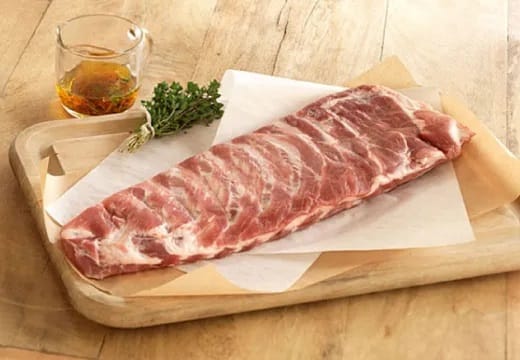
St. Louis ribs are a specific cut and preparation of pork ribs. The ribs are cut from the pork loin, the amount of meat that runs along the animal’s spine. The ribs are cut with a particular shape, so they look like a “St. Louis” shape. The ribs are trimmed to remove the brisket, the fat between the ribs, and the loin.
Once the ribs have been trimmed and cut, they are rubbed down with a special blend of spices and herbs. This helps draw out the pork flavor and gives the ribs a smoky flavor. The ribs are then slow-cooked, usually over indirect heat, until tender and juicy.
The result is a tender, smoky, and flavorful rib that is packed with flavor and juiciness. St. Louis ribs can be eaten on their own or served with traditional BBQ sides such as coleslaw, potato salad, and baked beans. They are also the perfect addition to any BBQ dinner, as they are a great accompaniment to ribs, chicken, and other grilled meats.
What are Spare Ribs?
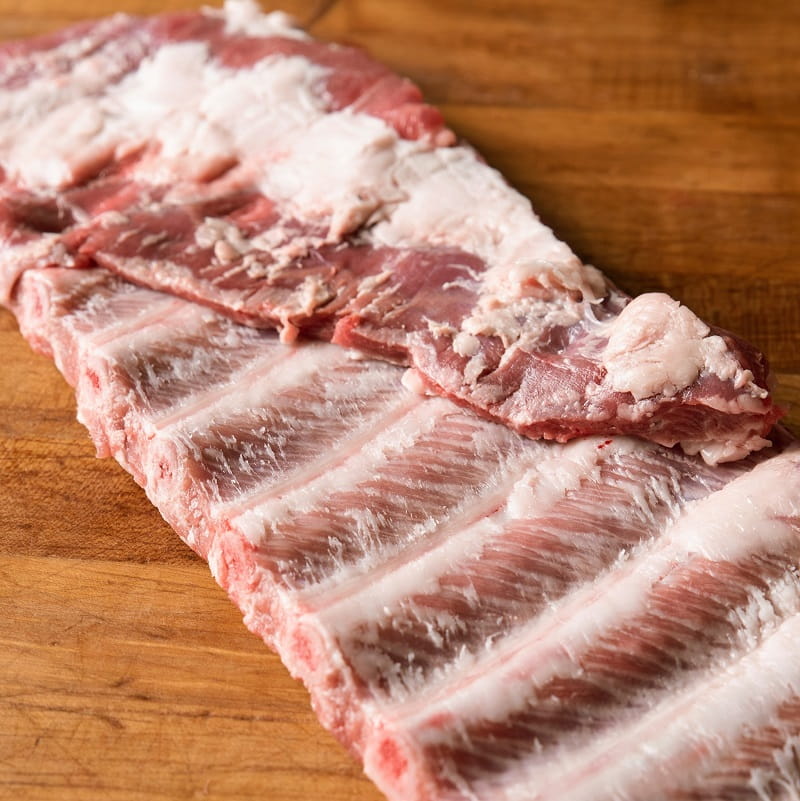
Spare ribs are cut pork ribs taken from the lower belly of the pig. As the name implies, spare ribs are an extra cut of pork ribs. This is because the lower belly of a pig contains more fat and connective tissue than other areas. As a result, spare ribs tend to be more tender, juicy, and flavorful than other ribs.
Spare ribs come in several varieties and can be prepared in various ways. The most popular way to cook spare ribs is to slow-roast them in the oven. This method results in tender, juicy ribs with a smoky, delicious flavor. Grilling is another popular way to prepare spare ribs and is an excellent option if you’re looking for a quick and easy meal.
Spare ribs can also be used in a variety of recipes. From classic barbecue to Chinese-style dishes, spare ribs are versatile ingredients that can be used in various dishes. Additionally, spare ribs can be used to make a delicious sauce or marinade if you want to add extra flavor to your dishes.
St Louis Ribs and Spare Ribs: What’re The Similarities
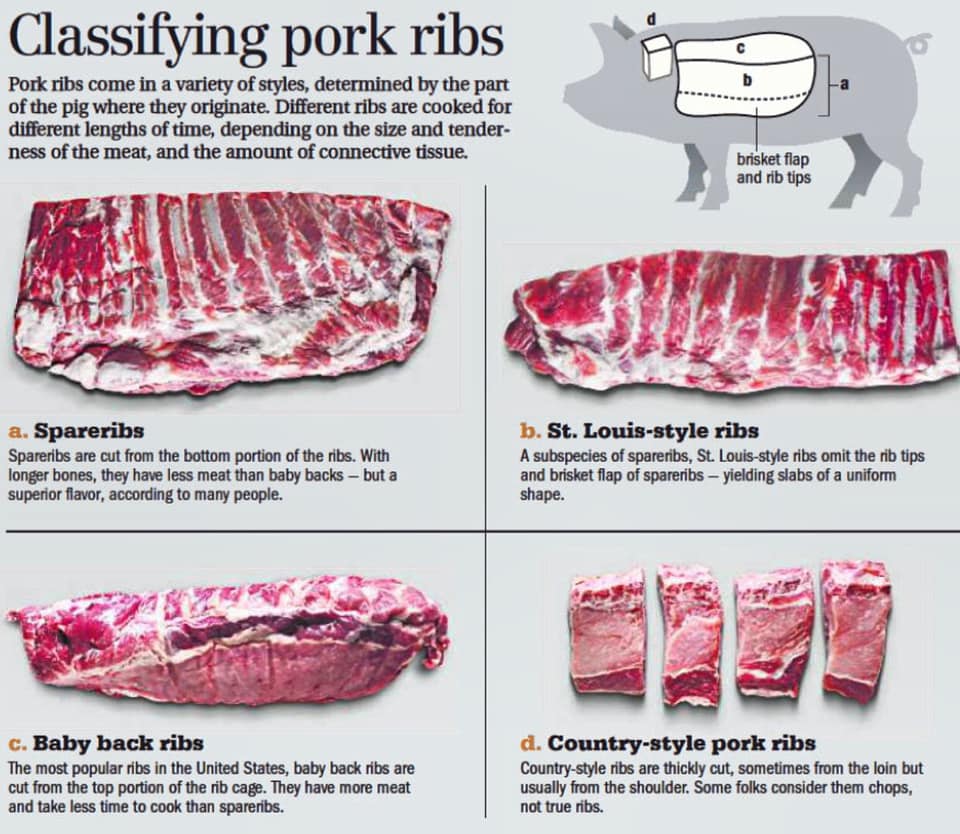
While the two types of ribs come from the same animal, they’re quite different. But what do they have in common? Let’s look at the similarities between St. Louis ribs and spare ribs.
First, it’s important to note that both St. Louis ribs and spare ribs come from the same part of the pig. St. Louis ribs are cut from the pork rib section, which is located between the shoulder blade and the backbone. Spare ribs, on the other hand, are cut from the belly section of the pig.
Second, both types of ribs are typically cooked similarly. St. Louis ribs and spare ribs are typically rubbed with spices, smoked, and cooked slowly over low heat. This slow cooking process helps to keep the ribs tender and juicy.
Third, both St. Louis ribs and spare ribs are usually served with various sauces. While there are many different types of sauce, some of the more popular options include barbecue sauce, honey mustard, and hot sauce.
Finally, both St. Louis ribs and spare ribs can be served as a main course or side dish. Many restaurants serve St. Louis ribs as a main course, while spare ribs are usually served as a side dish.
What Are The Main Differences Between St Louis Ribs vs Spare Ribs
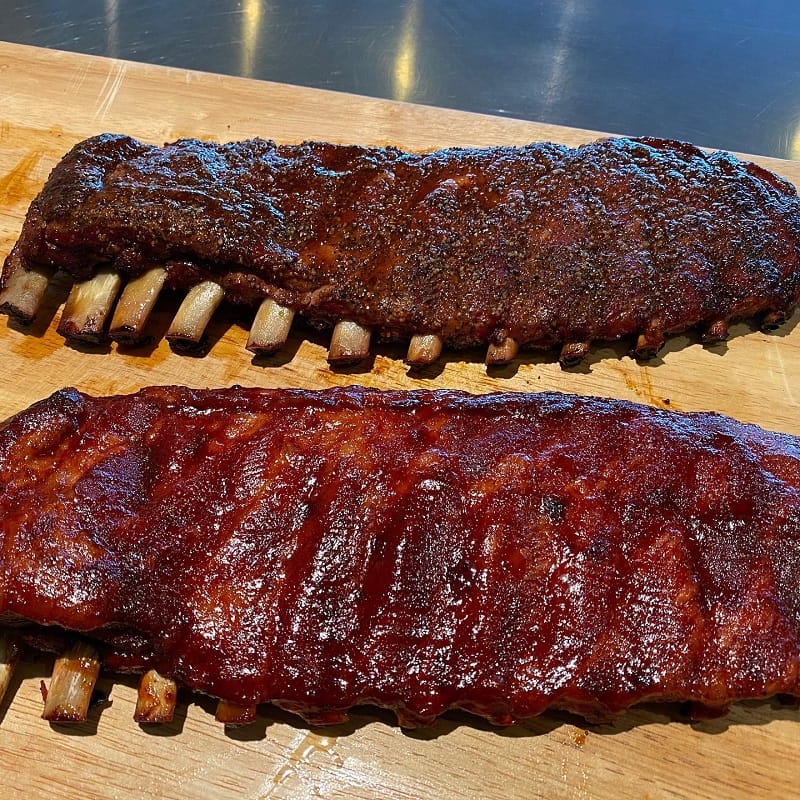
Although the difference between the two is minimal, St Louis ribs are essentially spare ribs that have been trimmed down to a neat rectangular package. This trimming involves the removal of the sternum, cartilage, and rib tips, resulting in a flatter and meatier cut than traditional spare ribs. This makes the rack of ribs easier to accommodate on the grill and helps them cook more evenly. St Louis-style spare ribs are cut from the belly of the hog after the belly is removed, and they have a higher amount of meat and bone than baby back ribs.
Both ribs are delicious and can be cooked up in various ways, but there are some key differences that you should know before deciding which one to make. Let’s look at each one to decide which rib type is right for you.
Location
St. Louis-style ribs come from the center section of the rib cage, while spare ribs are cut from the lower part of the rib cage. St. Louis-style ribs are flatter and more uniform in size, while spare ribs include more cartilage and may be curved in shape.
Calories
St. Louis-style ribs are leaner and contain fewer calories than spare ribs. A 3-ounce serving of St. Louis-style ribs contains about 200 calories, while the same amount of spare ribs contains around 270 calories.
Louis Ribs vs Spare Ribs: Flavor and Texture
The flavor and texture of St. Louis-style ribs are slightly different from spare ribs. St. Louis-style ribs are known for their sweeter, milder flavor and tender texture. Spare ribs, on the other hand, have a stronger, smokier flavor and a chewier texture.
Which Type Of Rib Is More Tender: St. Louis Ribs Or Spare Ribs?
In general, St. Louis-style ribs are considered to be more tender than spare ribs. This is because of their leaner, more uniform shape and size. Spare ribs are often considered to be tougher because they include more cartilage.
Which is More Tender?
Regarding tenderness, St Louis ribs are considered the more tender cut. This is because they come from the loin area, considered the most tender part of the rib. They have a higher fat content than spare ribs, and the fat provides a tenderness not found in spare ribs.
Which Type Of Rib Cut Is Better For Grilling?
When it comes to grilling, St Louis ribs are the preferred option. This is because they have a higher fat content, which helps to keep them from drying out during the grilling process. Spare ribs, on the other hand, are better for braising or slow cooking.
Serving
St Louis ribs are typically served whole, while spare ribs are usually in racks or individual ribs. Whole racks of St Louis ribs can be difficult to handle on the grill, so spare ribs are probably the better choice if you are looking for ease of serving.
Preparation And Cooking Time
St Louis ribs take longer to prepare and cook than spare ribs. This is because they are thicker and have a higher fat content that can take a while to render properly. Spare ribs, on the other hand, are thinner and can often be cooked faster.
Are St. Louis Ribs Or Spare Ribs Easier To Work With For Barbecuing?
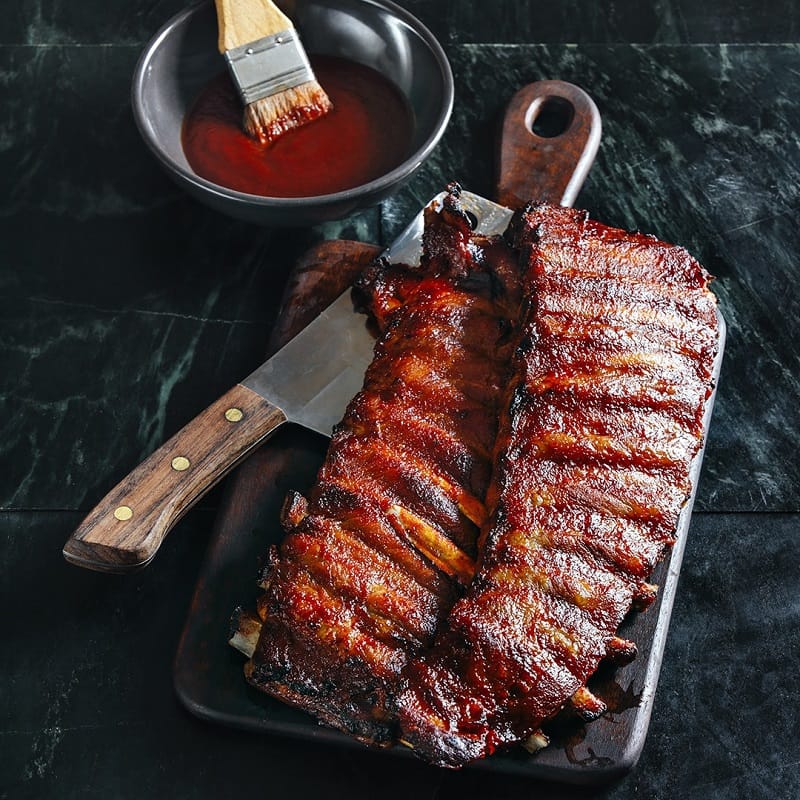
When it comes to barbecuing, St. Louis Ribs are considered the easier option. These ribs are cut from the lower part of the pork rib cage, which is a much thinner cut than spare ribs. This makes them easier to cook over a direct flame, and they tend to cook faster than spare ribs. Spare ribs, on the other hand, are thicker, which makes them more challenging to work with, and you may need to adjust your cooking time and technique to ensure they don’t burn.
Which Type Of Ribs Is Best For Slow-Cooking
When it comes to slow-cooking ribs, both St. Louis and spare ribs can be used. However, spare ribs are generally considered the better option for slow cooking since they are juicier and more flavorful than St. Louis ribs. Spare ribs also benefit from being cooked low and slow, giving them more time to absorb your grill’s delicious smoky flavor.
Cost
When it comes to cost, both types of ribs are fairly affordable. However, St. Louis ribs are typically cheaper than spare ribs, so if you’re on a budget, they’re the way to go.
Which Type Of Rib Cut Is Easier To Find At The Grocery Stores Or Butchers
Spare ribs are generally the more widely available cut of pork ribs. Most grocery stores and butchers carry spare ribs, whereas St. Louis ribs may be harder to find. If you’re having trouble finding St. Louis ribs, you may want to check out your local butcher or specialty stores.
Spare Ribs vs Louis Ribs – Which Ribs are Better for You?
When it comes to nutrition, spare ribs are the better choice. This is because they are a leaner cut of pork, which means they contain less fat and fewer calories than St. Louis ribs. However, both types of ribs contain protein and other essential nutrients, so you should feel free to enjoy either one as part of your overall healthy diet.
Read more:
How to Cook Louis Ribs
You will need the following:
- 3-4 pounds St Louis Ribs
- 1 cup (or more if needed) Barbecue sauce of your choice
- For the spice rub:
- 1 tbsp salt
- 2 tsp black pepper
- 2 tbsp paprika
- 1 tbsp garlic powder
- 1/2 tsp cayenne pepper
- 2 tsp dried oregano
- 1 tbsp brown sugar
First, you’ll need to prepare the marinade. Combine all ingredients for the marinade in a small bowl and rub both sides of the ribs with it. Let the ribs absorb the spices for at least 15 minutes. This will ensure that the ribs are packed with flavor.
Now it’s time to cook the ribs! Preheat your oven to 350°F and place a rack in the middle. Wrap the ribs in aluminum foil and place them on a baking sheet. Bake for 2 hours, or a little less, until the ribs are tender.
Once the ribs are tender, remove them from the foil and generously brush them with barbecue sauce. Return them to the oven and bake for 20-25 more minutes, until the sauce has warmed up and turned darker.
You’re almost done! Cut the ribs into individual pieces and serve. This recipe is sure to please the whole family. Enjoy!
How to Cook Spare Ribs
You will need the following:
- RIBS: 2 to 2 1/2 pounds baby back pork ribs
- Salt and black pepper
- SWEET AND SPICY BARBECUE SAUCE
- One tablespoon of olive oil
- 1/4 cup finely diced onion
- 1/2 teaspoon ground cumin
- 1/2 cup ketchup, try our homemade ketchup recipe
- One tablespoon of hot chili sauce (suggest Sriracha)
- Two tablespoons light brown sugar
- One tablespoon of apple cider vinegar
- Salt and ground pepper, to taste
Cooking ribs at a low temperature for a more extended amount of time will allow the fat and connective tissue to break down and create a more tender rib. You must heat your oven to 275° Fahrenheit (135°C) for this method.
Once your oven is preheated, it’s time to season your ribs. Generously season both sides of the ribs with salt and pepper. If you’re using a spice rub, season the ribs with it now. Place the ribs, meat-side up, into a large roasting pan or rimmed baking sheet. Cut the ribs in half to fit into the pan may be necessary.
Cover the pan or baking sheet tightly with aluminum foil and bake until the meat falls quickly from the bones, which can take 2 ½ to 3 ½ hours. We recommend checking the ribs after 2 hours to see how they progress. The ribs are done when the meat is cooked through and tender.
Once the ribs are cooked and tender, remove them from the oven and discard the aluminum foil. Generously brush both sides with barbecue sauce. For added flavor, you can turn on your oven’s broiler and broil the ribs for 3-4 minutes until the barbecue sauce caramelizes.
Make barbecue sauce:
- While the ribs bake, make the barbecue sauce. Heat the olive oil in a saucepan over medium heat.
- Add the onions and cook until soft and translucent, 5 to 8 minutes. Stir in the cumin and cook for an additional 30 seconds.
- Add the ketchup, hot chili sauce, brown sugar, and apple cider vinegar. Stir to combine, season with salt, then cook for 2 minutes. Set aside in preparation for the ribs to finish roasting.
How to Trim Spare Ribs to Become St Louis Cut?
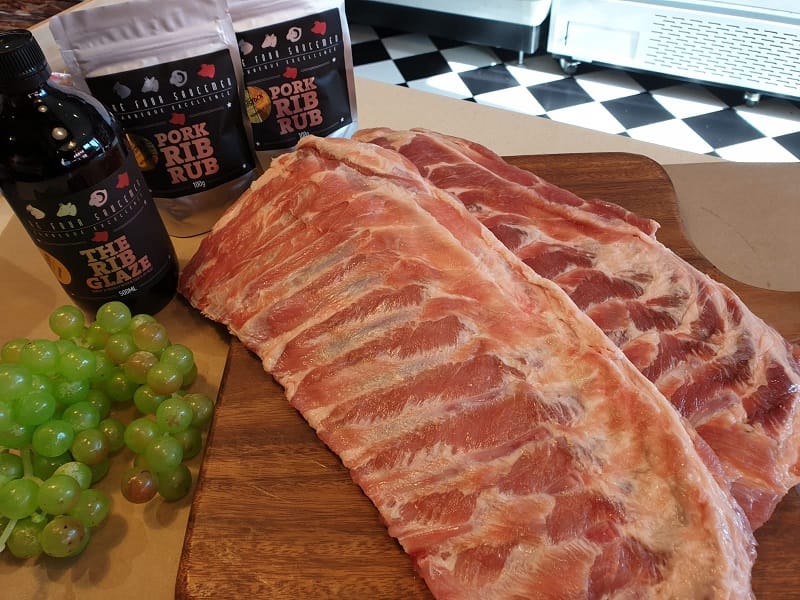
While it may seem daunting, trimming spare ribs to become St. Louis Cut ribs is quite easy with the right tools and techniques.
- Start by carefully removing the membrane covering the spare ribs’ back. This membrane is called the “silverskin,” and it’s very tough and chewy. Use a sharp knife to scrape it away from the meat carefully.
- Once you’ve removed the silverskin, it’s time to trim the fat from the ribs. Use a sharp knife or scissors to remove excess fat from the ribs carefully. Try to keep the fat evenly throughout the rib surface.
- Next, take a look at the rib bones. If the bones have sharp edges or are bowing out, you’ll want to cut them off. Use a sharp knife or scissors to remove the bones from the meat.
- Now it’s time to shape the ribs. Start by cutting away any excess flap of meat. Then, use a sharp knife to create a curved shape for the ribs. Cut away excess meat and fat until the ribs are smooth.
- Finally, use a sharp knife or scissors to trim any excess fat or meat hanging off the ribs.
Tips For Choose The Perfect Spare Ribs and Louis Ribs
First, you’ll want to determine what type of ribs you want. Spare ribs are cut from the back of the pig and are known for their rich flavor and juicy tenderness. Louis ribs are cut from the front of the pig and are known for their leaner texture and smokier taste.
Once you’ve determined the type of ribs you’re looking for, it’s time to select the right size. Spare ribs are usually sold as a full slab, but you can also buy individual ribs to control the portion size. Louis’s ribs are generally sold as a half slab, which makes them perfect for sharing.
Next, you’ll want to consider the marinade or seasoning you’ll use for your ribs. Depending on the type of ribs you’re cooking, you may want to use a sweet and tangy marinade or a spicy rub. Experiment with different flavors until you find the best marinade or rub you love.
Finally, take a look at the texture of the ribs. Spare ribs should have a nice, even marbling of fat and lean meat, while Louis ribs should be leaner with some visible fat.
Now that you know how to choose the perfect spare ribs and Louis’s ribs for your next BBQ, it’s time to fire up the grill and get cooking. The fat content of the ribs will affect the overall flavor, so make sure to look for ribs with the right amount of fat.
How to Store Probably Spare Ribs and Louis Ribs?
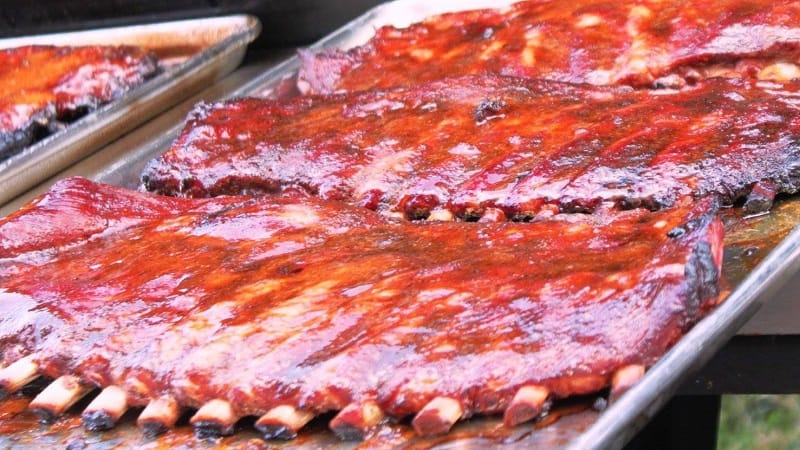
Storing ribs can be tricky for some people, but it doesn’t have to be. With a few simple steps, you can ensure your spare and Louis’s ribs stay fresh and delicious for months. Here’s how to store spare ribs and Louis ribs the right way:
- Buy the freshest ribs possible. Check the “sell by” date if you’re buying pre-packaged ribs. The best time to buy ribs is during the cooler months of the year when the meat is freshest.
- When you get home, unwrap the ribs and place them in a big container to fit them comfortably. If the ribs are still in their original packaging, label them with the date you bought them.
- Now that the ribs are in the container cover them with cold water. This will help keep the ribs moist and prevent them from drying out.
- Place the container in the refrigerator and let it sit for two to three days. This will give the ribs enough time to cool down and become cold.
- Once the ribs have cooled down, it’s time to wrap them. Place a piece of wax paper on top of the ribs, then wrap them in aluminum foil. Make sure the ribs are completely covered.
- Now that the ribs are wrapped in foil place them in the freezer. This will help them keep for up to three months.
FAQs About St Louis Ribs vs Spare Ribs
What Type Of Wood Or Charcoal Is Best For Smoking St Louis Ribs Vs. Spare Ribs?
When it comes to smoking ribs, the type of wood or charcoal used can greatly enhance the flavor. Traditional woods like hickory, oak, and mesquite are excellent choices for pork ribs, including St. Louis and spare ribs. These woods deliver a stronger smoke flavor, complementing the juicy and flavorful meat. However, fruitwoods like cherry, apple, and pecan are excellent options for those who prefer a milder smoke flavor. Additionally, St. Louis ribs are a better option when cooking indoors due to their flatter shape.
Ideal Sauces for St Louis Ribs and Spare Ribs
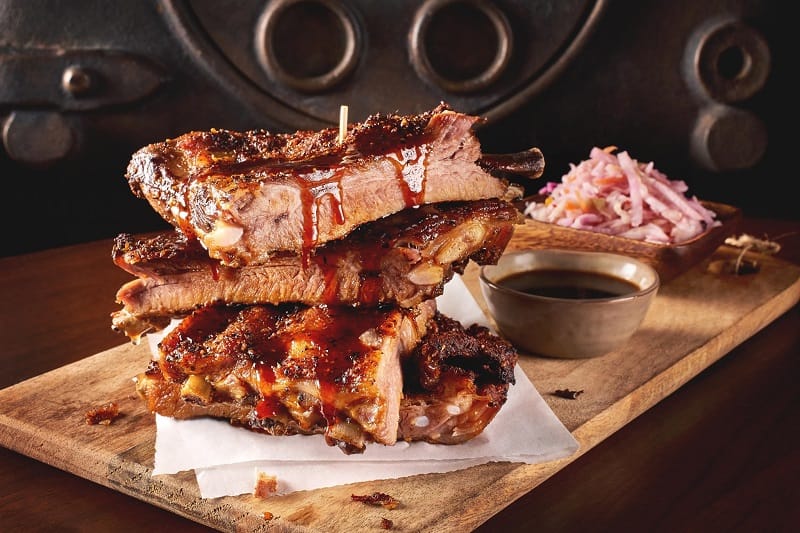
When it comes to St Louis ribs and spare ribs, the ideal sauces will depend on personal preference. Some people enjoy a spicy sauce with these ribs, while others prefer a tangy or sweet sauce. No matter what sauce one chooses, it’s important to make sure it complements the flavors of the ribs.
For those who like spicy ribs, a sauce made with chipotle peppers or hot sauce would be a great choice. If tangy is more their style, a sauce made with vinegar and mustard would be perfect. And honey or brown sugar sauce will do the trick for those with a sweet tooth. Ultimately, the perfect sauce for St Louis ribs and spare ribs enhances the meat’s flavors and satisfies the taste buds.
Conclusion
To conclude, St Louis ribs and spare ribs are two pork ribs famous in the United States. Both ribs offer a delicious flavor, but they can be cooked in different ways. St Louis ribs are wider and thinner with a small layer of fat, while spare ribs are thicker and meatier. St Louis ribs can be cooked faster and more evenly, while spare ribs are usually cooked at a lower temperature and for a longer period of time.
Ultimately, the decision comes down to personal preference, so it’s important to try both styles of ribs and see which one you prefer. No matter which type of rib you choose, one thing is certain – you’ll be enjoying a delicious dinner! “St Louis ribs vs spare ribs” is a popular debate that won’t be solved anytime soon, but you’ll be a winner no matter your choice!
References:

Hey readers! Chip Holland here, and I’m a Manager of this website. My passion for writing about it only matches my passion for BBQ. Follow my blog for mouth-watering recipes, tips, and tricks for the perfect smoke, grill, and BBQ. I’m sure you won’t be disappointed!
